When SHTF, and it will happen at some point, there is one thing that will ensure your survival… Food.
Feeding yourself and your family is a top priority in a crisis.
With an economic collapse looming closer each day, preparing for an emergency is no longer just an option. It is mandatory.
Stressing the importance of creating a plan for the future has little effect if that plan relies on the system for food. While none of us want to think about what could happen, the outcome is bleak without proper preparation.
The current economic climate is unstable at best and only worsens with each passing day.
While more vibrant than some, our economy is teetering on the edge of failure, and it is only a matter of time until we slip.
Related: Rampant Inflation: 10 Things To Do Before It’s Too Late
The economic climate impacts the production of many foods and your access to them. If you think the prices at the grocery store are bad now, they will get far worse should the inevitable occur.
How The Economic Climate Impacts Food Production And Access
Our economic climate impacts food production and access in several essential ways.
- Access to Resources: In times of economic hardship, there will be less access to resources such as seeds, fertilizer, and irrigation equipment. These limitations can make it more challenging to grow food for yourself, let alone for mass production.
- Market Conditions: The economic climate also affects market conditions, making growing certain crops more or less profitable. For example, if prices for certain crops are low, farmers may be less likely to plant them, which can affect availability.
- Policy: Economic conditions often influence government policies related to agriculture, such as subsidies or tariffs. Changes to policy can affect the profitability of growing certain crops or distributing them to specific areas.
- Natural Disasters: The economic climate impacts our ability to recover from damage caused by a natural disaster. Droughts and floods, for example, cause significant damage to crops and farmland, limiting access and making it more challenging to grow food in the future.
Overall, the economy significantly impacts our access to fresh, healthy food.
Related: Looming Economic Crisis Threatens To Push Millions Of Americans Into Starvation
With costs already reaching record highs, where does that leave you? Do you think you will be able to afford food in a year? In 5 years? Even if you can afford it, will you be able to get it?
These questions, which were once the concern of a select few, are now a common concern of many. So what can you do? How can you prepare?
Preparation begins with self-sufficiency, and growing your food is a big part of being self-sufficient. Below is a list of crops you should grow now to ensure that you are ready later.
Survival Foods You Need to Grow Now
While researching this article, I found a post online that said, ‘Food will get you through times of no money better than money will get you through times of no food.’ I don’t think there is a better way to explain the issue.
You can survive without money, and while it may not be fun, it can be done. On the other hand, food is a necessity of life that we cannot live without.
Thus, growing what you can in your yard or even on your balcony could be the difference between your survival and your demise.
Potatoes
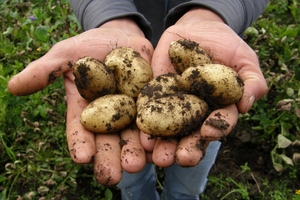 Growing potatoes is an excellent idea.
Growing potatoes is an excellent idea.
Potatoes are a staple food that is easy to grow in any climate and you can store for a long time.
Potatoes are also a good source of carbohydrates and vitamin C, which will be important when SHTF.
Onions
Onions are a staple food that can be grown in most climates and requires little effort.
Moreover, they can be stored for a long time and are a good source of vitamin C and other nutrients.
Beans
A terrific source of protein, beans can easily be grown in most areas. There are many beans to choose from, and they can be stored for a long time, especially when they are dried before storing.
Carrots
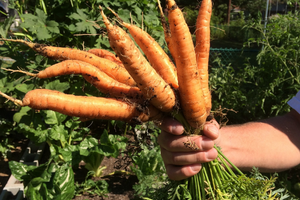 Another excellent survival food that is easy to grow and store is carrots.
Another excellent survival food that is easy to grow and store is carrots.
Carrots can be grown in various soils and across many climates. They are an excellent source of vitamin A and fiber.
Related: How To Preserve Your Vegetables Using Sand
Even better is that a single crop can yield a large harvest, and there are many methods to store carrots long-term.
Nuts
Some varieties of nuts, such as almonds, hazelnuts, and chestnuts, can be grown in a home garden.
Nuts are an excellent source of protein and healthy fats and can easily be stored in an airtight container for later use.
Corn
Easy to grow in most climates, corn is a crop you should consider farming.
Corn is a good source of carbohydrates and other nutrients and can be eaten fresh, dried, or ground into a meal or flour to be stored for extended periods
Garlic
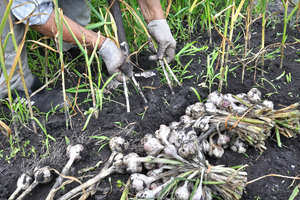 Growing garlic is easy, and it can be stored for extended periods, with various methods out there that can help to make it last longer.
Growing garlic is easy, and it can be stored for extended periods, with various methods out there that can help to make it last longer.
Garlic is an absolute essential in my house. It is a good source of vitamin C and other nutrients and has a variety of medicinal uses as well.
For example, garlic has long been used medicinally, but it has recently been shown to positively impact those suffering from cardiovascular diseases. Here you can learn more about how to use garlic as a medicine when SHTF.
Root vegetables
Vegetables such as turnips, radishes, and beets are considered root vegetables. These plants are often packed full of nutrients, are easy to grow, and can be stored for a long time.
Apples
Probably one of the best foods to eat, apples can be grown at home in your garden, provided you have enough space.
Apples are a good source of vitamins and minerals and can be eaten fresh or preserved for storage.
Tomatoes
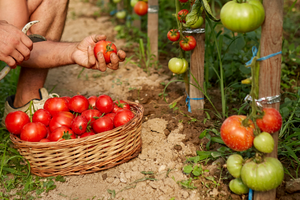 This staple food can be grown in most climates with ease.
This staple food can be grown in most climates with ease.
Tomatoes are another plant that has the potential to yield a significant harvest and are a good source of vitamin C.
Storage is the most significant barrier with this plant.
Related: How to Can Simple Tomato Sauce from Fresh Tomatoes and Peppers
Generally speaking, as they are, you can store tomatoes for a short period.
However, there are many ways to keep tomatoes long-term, making them an excellent addition to any food stockpile.
Peas
As with all the listed crops, peas are pretty simple to grow. Additionally, peas are a good source of protein and you can grow them in most climates.
You can store peas for a short period without any prep, but there are ways to create long-term storage solutions.
Squash
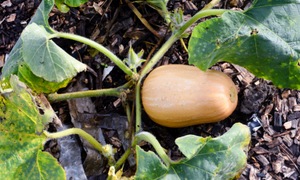 A versatile vegetable, squash is a good source of vitamin C and other nutrients and can be grown anywhere.
A versatile vegetable, squash is a good source of vitamin C and other nutrients and can be grown anywhere.
Thanks to its thick, waxy exterior, you can also store squash for a long time, especially if you are lucky enough to have a cold cellar.
If you don’t have a root cellar, here’s a cheap and easy way to build a root cellar in your backyard.
If you plan to keep squash, try not to let it touch other squash. These vegetables need their space and do much better when they are not piled on top of one another.
Berries
Often a favored fruit, you can usually grow berries in a simple home garden without experience, including strawberries, raspberries, and blueberries.
They are a good source of vitamins and minerals, and while they tend to spoil quickly when fresh, berries can easily be preserved for extended storage.
Melons
One of my favorite snacks, melons, such as watermelons and cantaloupes, can be grown in many climates and are a good source of hydration and other nutrients. Melons can be eaten fresh or are easily preserved for later.
Leafy Greens
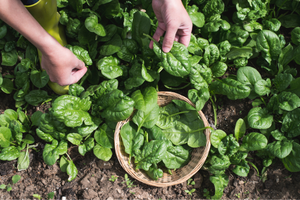 Lettuce, spinach, and kale are considered leafy greens.
Lettuce, spinach, and kale are considered leafy greens.
They are easy to grow almost anywhere.
Furthermore, if done right, these plants can be harvested multiple times throughout the growing season, providing a big bang for your buck.
Leafy greens are a good source of vitamins and minerals and can be eaten raw or cooked.
Herbs
Growing herbs, such as basil, oregano, and rosemary, is easy, and you can use them to add flavor to a variety of dishes.
Related: 15 Best Herbs for Your Prepper Garden
Many herbs also have medicinal properties and you can use them to treat a variety of ailments.
Peanuts
An excellent source of protein and healthy fats, peanuts can be grown in many climates.
This delicious snack can be eaten fresh, roasted, or used to make peanut butter. They are also easy to store long-term and outstanding in an emergency stockpile.
Grains
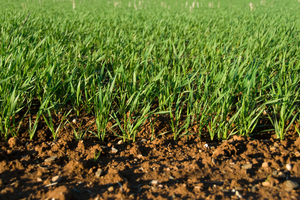 Some grains, such as oats and wheat, can be grown in a home garden.
Some grains, such as oats and wheat, can be grown in a home garden.
You can use these grains to make bread, cereals, and other foods.
Since grains are a good source of protein and other nutrients, they are an excellent addition to any stockpile.
Pumpkins
I often forget that you can eat pumpkins. However, pumpkins grow well in most climates, are not picky about their soil, and are versatile vegetables.
They are a good source of vitamin A and other nutrients. You can eat pumpkins fresh, baked, or you can preserve them for later use.
Rice
Yet another staple food that can come in handy when SHTF. Rice is easy to grow in many parts of the world. It is also a good source of carbohydrates and other nutrients.
It is important to note that rice is typically grown in flooded fields. Thus, if you want to grow your own rice, you will need access to a water source.
With the precarious state of the world, growing even a few items on this list is a good idea. Grocery store prices are at an all-time high, and shelves are often bare. Thus, gaining self-sufficiency by growing your food at home could be a potential lifesaver.
This is not a comprehensive list of all the foods you can grow in your garden, but it should provide you with some ideas. I would love to hear what you grow in your garden and how it has helped you survive these difficult times. Stay safe!
You may also like:
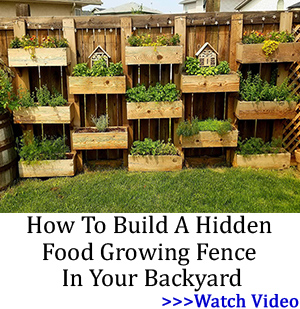 What Really Happens to Your Guns in Winter (it could get you killed)
What Really Happens to Your Guns in Winter (it could get you killed)
If You See This Plant In Your Backyard, Don’t Step On It (Video)
9 Home Security Mistakes That You Are Probably Making Right Now

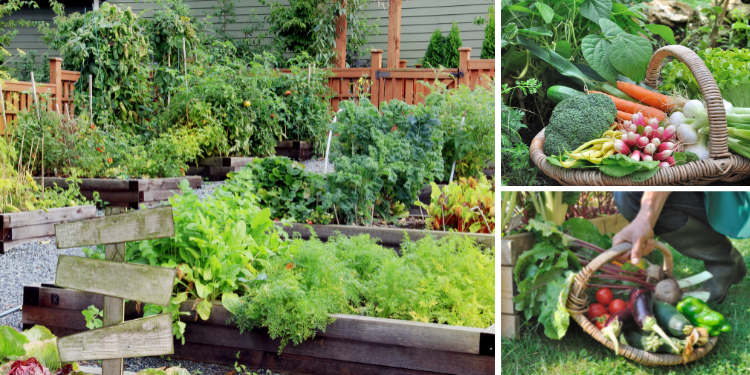













This is what’s coming.
EU’s. New ESG Reporting Rules will apply to many US Issuers.
This means that if you do not go alog, you as a company,You CAN NOT SELL.
Look it up. They are telling us, you will play there game or ELSE…
BETTER start growing your own food.
stay sharp.
Pretty good list.
Nut trees take a few years to grow before you get nuts. But there are wildcrafted nuts like pine nuts and such if your blessed. Squirrels will be serious competition for them.
I’s suggest cabbage for vit C in stored foods. Scurvy is a terrible preventable disease. Cabbage processed into Kimchee or Sauerkraut maintains vit c quite well.
Winter squashes store well as described. Zucchini and yellow summer squashes not so much. But they can be dehydrated for storage and rehydrate well. Summer squash sliced into noodle style strips makes decent lasagna “noodled”.
Learn how to save seeds and the first-last frost in your area as so to know when to plant.
Gardening is a local skillset. What works well for me in New England might not work for you.
very good information Michael.
Might I add to this, that some of us may be very allergic to some nut trees and fruit trees, so take caution when just finding a tree with fruit or nut growing on it, that you just could have an allergic reaction to it or them.
Me, almonds and black walnut and others.
Michael, Lets come together and add much information to the site together and bury the hatchet.
I know that we can disagree and agree in a manner that is “still very beneficial to all of us” that come here to read or post, what they fill is right or wrong, even if it is stupid or dumb sounding.
I hope we are not the enemy to each other, and we stand shoulder to shoulder against the coming things that are coming. Out there is the enemy, not us.
stay sharp as all way’s
PS: not a sign of weakness, just bending like a tree limb connected to a strong tree…
It is getting mighty windy out Here…
Certainly I don’t always agree with what is posted, but generally I find it better to remain quiet. Frankly I would rather you, and others keep encouraging people in this direction rather than nit-pik on our differences. You have a good list, a well rounded list and people would benefit by heeding your suggestions. Another commenter brought up the ESG rules. I strongly encourage people to heed those warnings. The boogey man is coming, let there be no mistake. Please, please, please grow/produce all you can for your family. No, don’t go buying the premade pots and planters. Figure out how to make them from what you have.
That “talent” will be JUST as important as growing crops, or for that matter quail and chickens in your backyard. Figure out how to build that chicken coop from scraps you have salvaged in your neighborhood. Many of us grew up with building skills [among many other things] but so many were not afforded those opportunities. Take it now!
What are ESG rules?
Rules for you and companies to follow or you can’t travel, do business or bank
I love ripe melons
Not sure about growing rice
I’ve been growing veggies for over 50 years and I agree that this is an excellent list of veggies to grow. Would suggest that everyone who hasn’t yet grown their own food to read , read and read some more! Practice what you are learning along the way. Learn container gardening as well as ground gardening. Both will serve you well!
FYI: Masanobu Fukuoka, a Japanese soil scientist coming out of WWII who went ‘rogue’ and has become a permaculture icon, grew rice in non plowed, non flooded fields that produced heavier yields than the neighboring rice farmers’… his best known book, One Straw Revolution, goes into a number of his ideas that can be adjusted for anywhere using whatever is naturally available… I”d say his motto was ‘do less, get more’… tho it does take awareness and some experimentation… there are many YouTube videos by Larry Korn who basically introduced Fukuoka and his methods to the permaculture world..
I often lol because I started my own ag studies and experimentaion in Hawaii in the 70s and the Extension then and there was teaching techniques now known as ‘permaculture’ at the same time that ‘permaculture’ was supposedly being discovered/put together in Australia. If you are interested in learning more… (‘always learn more’ is my own motto)..bare in mind that there are a lot of different influences in permaculture pretty much anything else… many of which are unnecessary and/or not condusive everywhere… pick and choose what works for you and your land and climate.
Live in Southern N.H. and have been gardening for many years. Don’t know how or why, but some years certain crops don’t make it. Strongly suggest that you keep an extra years supply of seeds just in case that your yield is insufficient. Also, thick layers of straw over your potato bed prior to freezing will allow you to harvest into winter.
Regarding pumpkins. Any winter squash – EXCEPT jack-o-lantern pumpkins are good to eat and easy to grow. While they *can* be eaten, they are more work than they are worth. Garden space would be better used for any number of varieties. They can be space hogs, so keep that in mind.
I planted 8 Georgia candy squash seeds last year without paying attention to how big those plants are. Leaves are 15″+ across, vines 20 feet or more. And the squashes are enormous. They keep well and taste good, though, and as many as I’ve given away… I still have enough to eat a few a week for the rest of winter.
Pumpkins are squash. Other squash that keep well are Acorn and Turk’s Turban. You left out cabbage! Cabbage keeps for a long time; cut the heads and set them upside-down. Cover with a deep later of straw from your vintage wheat crop. Straw has lots of uses on the homestead.
Other, non-food items that can be grown are flax (linen fiber! — and the seed is good in minimal doses), thatch (still used to roof many houses in rural Scotland), and bulrush (bedding).
Don’t want the bother of a cow? Have a small herd of goats and a small flock of sheep for milk and meat. A pair of the old-fashioned Shetland ponies can do 3/4 of the work of a pair draft horse on less than half the feed, and can take you to market and back once things settle down ATSHTF.
You can feed your chickens with fresh squash (not canned please too much sugar) by simply cutting them in half. A great way to entertain them when they are cooped up due to New England Nor’easters. Happy chickens don’t eat eggs or pick on each other I’ve found.
Folks did have chickens before Purina chicken layer came around.
We all need peppers, flaming, hot or mild. They are loaded with vitamins and fiber and the hot ones can give you an endorphin rush and help with circulation.
They are great for flavoring all of the other veggies you listed. A meat onion and cornbread stuffed bell pepper hot out of the oven is dynomite on a cold day.
Great article. I’ve been trying to grow things, inside and outside. All I got, so far, is a TON of Jalapeños. Buying some more seeds online today.
Be careful: peanuts can harbor mold. Not always noticeable, but can be very bad for you. Maybe not deadly, but can cause many health issues.
There is always wild rice, not actually a rice, but a grain. Lots of good vitamins and minerals.
So sad that diabetics can’t really eat much of this good garden produce, but I’ll grow most all of it anyway.
I suggest “growing” chickens. They are able to be grown in many city neighborhoods. You don’t need a rooster (many city rules say no roosters) for eggs, only if you plan to raise chicks. This will give you a healthy, low carb protein.